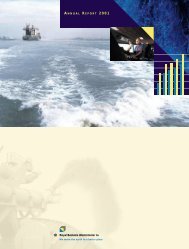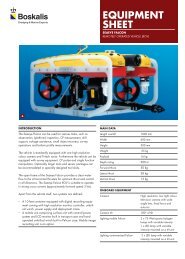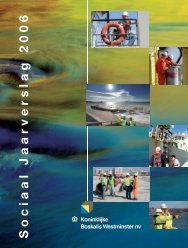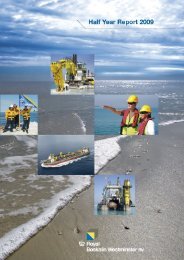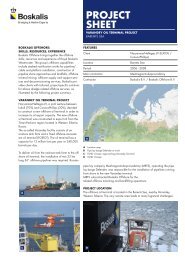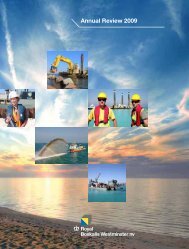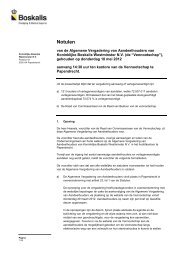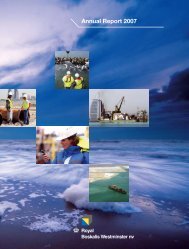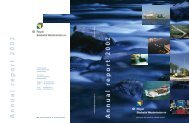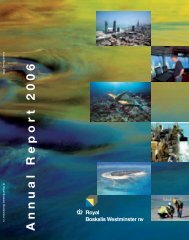Annual report 20108.31 MB - Boskalis
Annual report 20108.31 MB - Boskalis
Annual report 20108.31 MB - Boskalis
- No tags were found...
You also want an ePaper? Increase the reach of your titles
YUMPU automatically turns print PDFs into web optimized ePapers that Google loves.
Financial statements 2010the identifiable assets, liabilities and contingentliabilities of the acquiree. When the excess wasnegative, a bargain purchase gain was recognisedimmediately in profit or loss.Transaction costs, other than those associatedwith the issue of debt or equity securities, thatthe Group incurred in connection with businesscombinations were capitalised as part of the cost ofthe acquisition.Acquisitions prior to 1 January 2004 (date oftransition to IFRSs)As part of its transition to IFRSs, the Groupelected not to restate business combinations thatoccurred on or after 1 January 2004. In respectof acquisitions prior to 1 January 2004, goodwillrepresents the amount recognised under theGroup’s previous accounting framework.Accounting for acquisitions of non-controllinginterestsFrom 1 January 2010 the Group has applied IAS 27Consolidated and Separate Financial Statements(2008) in accounting for acquisitions of noncontrollinginterests. The change in accountingpolicy has been applied prospectively and has hadno impact on earnings per share.Under the new accounting policy, acquisitionsof non-controlling interests are accounted foras transactions with owners in their capacity asowners and therefore no goodwill is recognised as aresult of such transactions. The adjustments to noncontrollinginterests are based on a proportionateamount of the net assets of the subsidiary.Previously, goodwill was recognised on theacquisition of non-controlling interests in asubsidiary, which represented the excess of thecost of the additional investment over the carryingamount of the interest in the net assets acquired atthe date of the transaction.The principles for financial <strong>report</strong>ing subsequentlydisclosed are applied consistently for all periodsdisclosed in these consolidated financial statementsand have been applied consistently by theGroup entities.2.3 New standards and interpretations not yetadoptedA number of new standards, amendments tostandards and interpretations are effective forannual periods beginning after 1 January 2010,and have not been applied in preparing theseconsolidated financial statements. None ofthese is expected to have a significant effecton the consolidated financial statements of theGroup, except for IFRS 9 Financial Instruments,which becomes mandatory for the Group’s 2013consolidated financial statements and could changethe classification and measurement of financialassets. The Group does not plan to adopt thisstandard early and the extent of the impact has notbeen determined.3. Principles of financial <strong>report</strong>ing3.1 Format and valuationThe consolidated financial statements are drawnup in euros, the Group’s functional currency.The consolidated financial statements are basedupon historical cost to the extent that IFRS doesnot prescribe another accounting method forspecific items. Preparing financial statements inaccordance with IFRS means that estimates andassumptions made by the management partlydetermine the recognized amounts under assets,liabilities, revenues and costs. The estimates andassumptions are mainly related to the measurementof property, plant and equipment (useful life andimpairment), goodwill, valuation of investmentsin associated companies, results on completionof work in progress, pension liabilities, taxation,provisions and financial instruments. Judgementsmade by management within the application of IFRSwith an material effect on the Financial statementsare the qualifications of investments as Groupcompanies, joint ventures or associated companies.Details are incorporated in the explanatory notesto these items. Next to the elements alreadyexplained in the explanantory notes to the Financialstatements, there are no other critical valuationjudgements in the application of the principlesthat need further explanation. The estimatesmade and the related assumptions are based onmanagement’s experience and understandingand the development of external factors thatcan be considered reasonable under the givenRoyal <strong>Boskalis</strong> Westminster nv75



